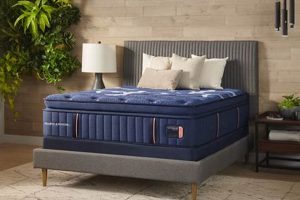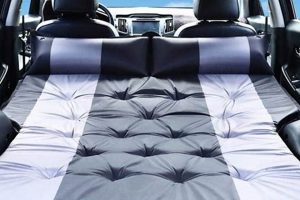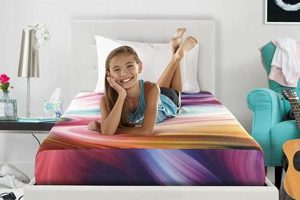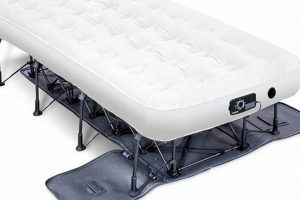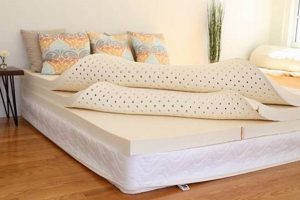The selection of a suitable sleeping surface for a trundle bed is critical. It refers to a mattress optimized for both comfort and the space constraints inherent in a trundle configuration, where the bed is stored under another bed. For example, a thinner innerspring or foam mattress is often favored to ensure proper storage and prevent interference with the upper bed.
Appropriate selection yields multiple advantages. It maximizes comfort for the sleeper while preventing damage to the trundle mechanism. Historically, trundle beds served as space-saving solutions, particularly in smaller living spaces or children’s rooms; thus, selecting a compatible mattress has always been vital to their functionality and longevity.
Subsequently, consideration will be given to factors influencing the selection process, including mattress type, thickness limitations, support requirements, and material considerations. These elements are crucial in arriving at an informed decision.
Guidance on Selecting a Mattress for a Trundle Bed
The following recommendations are provided to assist in the selection process for a mattress intended for use in a trundle bed, with an emphasis on optimizing comfort, compatibility, and longevity.
Tip 1: Prioritize Thickness. Adhere to the manufacturer’s recommended height limitation for the trundle bed frame. Exceeding this limit will impede proper storage and may damage the frame. A common thickness range is between 5 and 8 inches.
Tip 2: Consider Foam Density. For foam mattresses, select a density appropriate for the intended user’s weight and sleep preferences. Higher density foams generally offer improved support and durability.
Tip 3: Evaluate Innerspring Coil Count. When selecting an innerspring mattress, a higher coil count typically correlates with enhanced support and reduced motion transfer. However, ensure the overall thickness remains within the acceptable range.
Tip 4: Assess Edge Support. Robust edge support is beneficial, particularly for individuals who tend to sleep near the edge of the bed. It prevents sagging and enhances the usable sleep surface.
Tip 5: Verify Material Composition. Prioritize hypoallergenic and breathable materials to promote air circulation and minimize the risk of allergic reactions. Consider CertiPUR-US certified foams to ensure low VOC emissions.
Tip 6: Check Weight Capacity. Confirm that the selected mattress can adequately support the weight of the intended user. Exceeding the weight capacity can compromise support and shorten the lifespan of the mattress.
Tip 7: Review Warranty Information. Thoroughly examine the mattress warranty to understand the scope of coverage and any limitations. A comprehensive warranty provides assurance against manufacturing defects.
Implementing these guidelines will help ensure that the chosen mattress offers both comfort and practicality within the constraints of a trundle bed configuration, promoting restful sleep and extending the functional life of both the mattress and the bed frame.
Subsequently, the article will address specific mattress types and their suitability for trundle beds.
1. Thickness limitations
Thickness limitations are a primary determinant in identifying an appropriate sleeping surface for a trundle bed. The design of a trundle bed inherently restricts the vertical space available for mattress storage when the trundle component is retracted. Consequently, exceeding the maximum permissible mattress thickness prevents proper closure of the trundle unit, rendering the space-saving feature ineffective and potentially damaging the trundle mechanism. For example, standard trundle bed frames typically accommodate mattresses ranging from 5 to 8 inches in thickness. Attempting to use a mattress exceeding this range will impede smooth operation.
The consideration of thickness influences other mattress characteristics. Thicker mattresses often incorporate more robust support systems, such as higher coil counts or denser foam layers. However, to remain within the specified thickness limitations, manufacturers must often compromise on these features when designing mattresses specifically for trundle beds. This trade-off necessitates a careful balance between comfort, support, and compatibility with the trundle frame. Consider the use case: a guest room trundle bed used infrequently might prioritize ease of storage over premium comfort, whereas a child’s primary sleeping surface may demand a more supportive, albeit thinner, mattress.
In summary, mattress thickness is not merely a dimension; it is a fundamental constraint dictating the feasibility and functionality within the trundle bed context. Recognizing and adhering to the thickness limitations is paramount in achieving a seamless integration of mattress and trundle frame, ensuring efficient space utilization and long-term operational integrity. Disregarding these limitations leads to operational difficulties and potential damage to the overall structure, undermining the purpose of the space-saving trundle design.
2. Comfort Support
Within the context of selecting an optimal mattress for a trundle bed, “Comfort Support” represents a critical intersection of ergonomic design and functional constraint. The limited thickness typically available for trundle mattresses necessitates a concentrated effort to maximize both comfort and spinal alignment. Insufficient support can lead to discomfort, disturbed sleep, and, over time, potential musculoskeletal issues. For instance, a trundle mattress lacking adequate lumbar support may exacerbate lower back pain, particularly in individuals who habitually sleep in certain positions. Therefore, comfort support is not merely a desirable attribute but a foundational element of a well-designed trundle mattress.
Achieving adequate comfort support in a trundle mattress requires strategic material selection and construction techniques. High-density foam, strategically placed support zones, and specialized coil systems are often employed to compensate for the limited thickness. Consider the difference between a basic foam mattress and one incorporating a layer of memory foam or gel-infused foam; the latter provides enhanced pressure relief and conforms more closely to the body’s contours, improving sleep quality. Similarly, an innerspring mattress with individually pocketed coils minimizes motion transfer and offers more targeted support compared to a traditional interconnected coil system. The choice of construction directly affects the overall comfort support profile.
In summation, comfort support in trundle mattresses is an essential factor influencing sleep quality and long-term physical well-being. The design challenge lies in optimizing this feature within the spatial limitations inherent to trundle beds. Prioritizing materials and con
struction techniques that maximize support and pressure relief is crucial. A trundle mattress that compromises on comfort support undermines its purpose as a reliable and restorative sleep solution.
3. Storage Space
In the context of selecting a suitable sleeping surface for a trundle bed, “Storage Space” represents a fundamental constraint that dictates feasible mattress options. The primary function of a trundle bed is its space-saving design, wherein an additional bed is stored underneath the main frame when not in use. The available storage space directly limits the dimensions, particularly the thickness, of the mattress that can be accommodated.
- Maximum Mattress Height
The trundle bed frame is engineered to house a mattress of specific dimensions. Exceeding the maximum allowable height obstructs the smooth retraction and extension of the trundle unit. For instance, a frame designed for a 6-inch mattress will not properly accommodate an 8-inch mattress, potentially damaging the frame or impeding its functionality. This constraint necessitates prioritizing thinner mattress profiles.
- Impact on Mattress Type Selection
The available storage space influences the type of mattress that can be considered. Thicker mattress types, such as pillow-top or hybrid models, are generally unsuitable due to their dimensional incompatibility. Consequently, thinner innerspring or foam mattresses are often the only viable options. For example, a memory foam mattress compressed to a 5-inch profile may offer acceptable comfort while remaining within the storage parameters, whereas a traditional innerspring exceeding this limit would be impractical.
- Long-Term Storage Considerations
In addition to immediate compatibility, long-term storage considerations are relevant. Mattresses stored in a compressed state for extended periods may experience degradation in support or comfort. Therefore, selecting a mattress material resistant to compression-induced deformation is beneficial. For instance, a high-density foam mattress is generally more resilient to prolonged compression than a low-density variant, maintaining its structural integrity over time.
- Trade-Offs Between Comfort and Storage
The limited storage space necessitates trade-offs between comfort and practicality. While a thicker mattress may offer superior comfort, it compromises the space-saving functionality of the trundle bed. A thinner mattress, while conforming to the storage constraints, may offer reduced support or pressure relief. For example, a child’s trundle bed might prioritize storage efficiency over premium comfort, whereas a guest trundle bed could prioritize comfort, provided the chosen mattress remains within the dimensional limits.
In conclusion, the “Storage Space” constraint is inextricably linked to the selection of an appropriate mattress for a trundle bed. Understanding and adhering to the dimensional limitations of the trundle frame is paramount. The available space dictates the types of mattresses that can be considered and influences trade-offs between comfort, support, and long-term storage viability. The chosen mattress should be selected to maximize both comfort and functionality within these physical parameters, thereby optimizing the utility of the trundle bed configuration.
4. Material Quality
In the realm of trundle bed mattresses, material quality is not merely a superficial attribute but a fundamental determinant of longevity, comfort, and overall value. The constrained dimensions of trundle mattresses necessitate that each component performs optimally, thereby maximizing the lifespan and utility of the product.
- Foam Density and Composition
The density and composition of foam layers directly affect support and durability. High-density foam, such as memory foam or latex, offers superior contouring and pressure relief compared to low-density alternatives. For example, a high-density memory foam layer can reduce motion transfer and provide targeted support for sleepers of varying weights, while a low-density foam may compress prematurely, leading to sagging and discomfort. The specific composition, such as CertiPUR-US certified foam, ensures low VOC emissions, promoting healthier sleep environments.
- Coil System Integrity
For innerspring trundle mattresses, the coil systems integrity is crucial. Tempered steel coils offer enhanced durability and resistance to deformation, particularly under prolonged use. The coil gauge, or thickness, influences firmness and support. For instance, a higher coil gauge provides a firmer feel, suitable for individuals requiring additional back support. The arrangement of coils, such as individually pocketed coils, minimizes motion transfer and conforms to the bodys contours, enhancing overall comfort. Inferior coil systems may exhibit premature sagging or breakage, compromising the mattresss support and longevity.
- Cover Fabric Durability and Breathability
The cover fabric protects the internal components of the mattress and contributes to sleep comfort. Durable fabrics, such as tightly woven cotton or polyester blends, resist tearing and abrasion, extending the mattress’s lifespan. Breathability is equally important, facilitating air circulation and moisture wicking to regulate temperature and prevent overheating. For example, a breathable cover made of natural fibers like bamboo can enhance airflow and promote a cooler sleep surface, while a non-breathable synthetic cover may trap heat and moisture, leading to discomfort. Material quality impacts overall product performance.
- Adhesives and Seams
The adhesives and seams used in mattress construction contribute to overall structural integrity. High-quality adhesives, such as water-based or non-toxic alternatives, ensure secure bonding of layers without compromising indoor air quality. Reinforced seams prevent separation and edge unraveling, particularly in areas subject to frequent stress. Inferior adhesives may degrade over time, leading to layer separation or off-gassing. Weak seams may fray or tear, compromising the mattress’s structural integrity and shortening its lifespan.
These facets of material quality collectively influence the performance and longevity of trundle bed mattresses. Selecting mattresses incorporating durable, high-quality materials optimizes comfort, support, and overall value, ensuring a reliable and restful sleep experience. Compromising on material quality invariably leads to reduced performance and diminished lifespan, negating the space-saving advantages of the trundle bed design.
5. Durability
Durability is a critical attribute in the context of trundle bed mattresses, directly impacting long-term value and user satisfaction. Due to space constraints and frequent use, trundle mattresses are often subjected to conditions that can accelerate wear and tear. Thus, selecting a durable mattress is paramount.
- Material Resistance to Compression
The materials used in trundle mattresses must withstand repeated compression from body weight,
as well as potential compression during storage when the trundle bed is retracted. High-density foams, such as memory foam or latex, generally exhibit superior resistance to compression compared to lower-density alternatives. For instance, a high-density foam mattress is less likely to develop lasting impressions or sagging over time, ensuring consistent support and comfort. - Edge Support Integrity
Edge support is a crucial durability factor, particularly for trundle mattresses used by individuals who sleep near the edge of the bed. Robust edge support prevents edge collapse and ensures a usable sleep surface across the entire mattress. Reinforced edges, often achieved through the use of high-density foam encasements or steel perimeter wires, maintain structural integrity and prevent premature wear. Example: A mattress with weak edge support may exhibit sagging or deformation along the edges, reducing the overall sleep area and potentially compromising comfort and safety.
- Fabric Wear Resistance
The mattress cover fabric must withstand abrasion from regular use and potential friction during trundle bed retraction and extension. Durable, tightly woven fabrics, such as high-thread-count cotton or synthetic blends, resist tearing, pilling, and seam separation. For example, a mattress cover made from a durable, abrasion-resistant material will maintain its aesthetic appeal and structural integrity for a longer period compared to a cover made from a weaker, less resistant fabric.
- Coil System Longevity (if applicable)
For innerspring trundle mattresses, the coil system is a primary determinant of durability. Tempered steel coils, known for their resilience and resistance to deformation, ensure long-term support and prevent sagging. The coil gauge (thickness) and the number of coils also influence durability, with higher gauge and coil counts generally correlating with increased lifespan. Example: An innerspring mattress with a high-quality, tempered steel coil system is less likely to develop coil fatigue or sagging, providing consistent support and comfort over many years of use.
These multifaceted aspects of durability are vital when evaluating a mattress for a trundle bed. A mattress that exhibits resistance to compression, features robust edge support, incorporates a wear-resistant fabric, and, if applicable, utilizes a high-quality coil system is more likely to provide lasting comfort, support, and overall value. Prioritizing durability translates to a longer-lasting product, reducing the need for frequent replacements and maximizing the benefits of the space-saving trundle bed design.
Frequently Asked Questions
The following questions address common concerns regarding mattress selection for trundle beds. These answers provide information to aid in making informed decisions.
Question 1: What is the recommended maximum thickness for a mattress intended for use in a trundle bed?
The recommended maximum thickness varies based on the specific trundle bed frame. However, a range of 5 to 8 inches is generally advisable to ensure proper storage and prevent interference with the upper bed.
Question 2: What type of mattress is most suitable for a trundle bed?
Thinner innerspring or foam mattresses are typically the most suitable options. Thicker mattress types, such as pillow-top or hybrid models, are generally not compatible due to space constraints.
Question 3: How does foam density affect the performance of a foam mattress in a trundle bed?
Higher density foams offer improved support and durability. This is particularly important in trundle beds, where thinner mattresses may require higher density to compensate for reduced overall thickness.
Question 4: Is edge support important in a trundle bed mattress?
Yes. Robust edge support prevents sagging and maximizes the usable sleep surface, which is particularly beneficial given the often-limited dimensions of trundle mattresses.
Question 5: What materials are recommended for trundle bed mattresses to minimize allergy risks?
Hypoallergenic and breathable materials are recommended. CertiPUR-US certified foams are also advisable to ensure low VOC emissions.
Question 6: How does weight capacity influence the selection of a mattress for a trundle bed?
Selecting a mattress with an appropriate weight capacity is crucial. Exceeding the weight capacity can compromise support and shorten the lifespan of the mattress.
The above information serves as a guideline for choosing a mattress for a trundle bed. It is important to consider individual needs and preferences when making a final decision.
The subsequent section will provide a summary of the key considerations discussed throughout this article.
best mattress for trundle bed
This exploration of the factors influencing the selection of the appropriate sleeping surface for a trundle bed underscores several key considerations. These include adherence to thickness limitations dictated by the frame, optimization of comfort support within those constraints, careful consideration of storage space implications, prioritization of durable and high-quality materials, and recognition of the importance of long-term durability. Failure to address any of these aspects can compromise the functionality, comfort, and lifespan of the mattress.
Choosing wisely ensures that the trundle bed performs optimally as a space-saving and comfortable sleeping solution. Prioritizing these points enables informed decisions to maximize sleep quality and extend the useable life of the mattress and trundle mechanism.


![Top-Rated Best Daybed Mattress [2024]: Buyer's Guide Organic & Natural Mattress Buyer’s Guide: Non-Toxic Sleep Solutions Top-Rated Best Daybed Mattress [2024]: Buyer's Guide | Organic & Natural Mattress Buyer’s Guide: Non-Toxic Sleep Solutions](https://mattressworldpa.com/wp-content/uploads/2025/07/th-7669-300x200.jpg)
